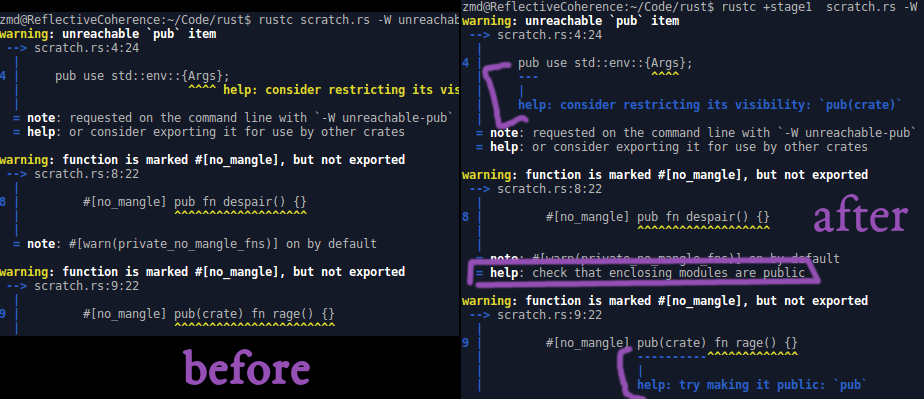fix `is_non_exhaustive` confusion between structs and enums
Structs and enums can both be non-exhaustive, with a very different
meaning. This PR splits `is_non_exhaustive` to 2 separate functions - 1
for structs, and another for enums, and fixes the places that got the
usage confused.
Fixes#53549.
r? @eddyb
Structs and enums can both be non-exhaustive, with a very different
meaning. This PR splits `is_non_exhaustive` to 2 separate functions - 1
for structs, and another for enums, and fixes the places that got the
usage confused.
Fixes#53549.
Fix#50865: ICE on impl-trait returning functions reaching private items
Adds a test case as suggested in #50865, and implements @petrochenkov's suggestion. Fixes#50865.
Impl-trait-returning functions are marked under a new (low) access level, which they propagate rather than `AccessLevels::Reachable`. `AccessLevels::is_reachable` returns false for such items (leaving stability analysis unaffected), these items may still be visible to the lints phase however.
add modifier keyword spans to hir::Visibility; improve unreachable-pub, private-no-mangle lint suggestions
#50455 pointed out that the unreachable-pub suggestion for brace-grouped `use`s was bogus; #50476 partially ameliorated this by marking the suggestion as `Applicability::MaybeIncorrect`, but this is the actual fix.
Meanwhile, another application of having spans available in `hir::Visibility` is found in the private-no-mangle lints, where we can now issue a suggestion to use `pub` if the item has a more restricted visibility marker (this seems much less likely to come up in practice than not having any visibility keyword at all, but thoroughness is a virtue). While we're there, we can also add a helpful note if the item does have a `pub` (but triggered the lint presumably because enclosing modules were private).

r? @nrc
cc @Manishearth
It was pointed out in review that the glob-exported
underscore-suffixed convention for `Spanned` HIR nodes is no longer
preferred: see February 2016's #31487 for AST's migration away from
this style towards properly namespaced NodeKind enums.
This concerns #51968.
Always check type_dependent_defs
Directly indexing into `type_dependent_defs` has caused multiple ICEs in the past (https://github.com/rust-lang/rust/issues/46771, https://github.com/rust-lang/rust/issues/49241, etc.) and is almost certainly responsible for #51798 too. This PR ensures we always check `type_dependent_defs` first, which should prevent any more of these (or at least make them easier to track down).
April 2016's Issue #33174 called out the E0446 diagnostics as
confusing. While adding the name of the restricted type to the message
(548e681f) clarified matters somewhat, Esteban Küber pointed out that we
could stand to place a secondary span on the restricted type.
Here, we differentiate between crate-visible, truly private, and
otherwise restricted types, and place a secondary span specifically on
the visibility modifier of the restricted type's declaration (which we
can do now that HIR visibilities have spans!).
At long last, this resolves#33174.
There are at least a couple (and plausibly even three) diagnostics that
could use the spans of visibility modifiers in order to be reliably
correct (rather than hacking and munging surrounding spans to try to
infer where the visibility keyword must have been).
We follow the naming convention established by the other `Spanned` HIR
nodes: the "outer" type alias gets the "prime" node-type name, the
"inner" enum gets the name suffixed with an underscore, and the variant
names are prefixed with the prime name and `pub use` exported from here
(from HIR).
Thanks to veteran reviewer Vadim Petrochenkov for suggesting this
uniform approach. (A previous draft, based on the reasoning that
`Visibility::Inherited` should not have a span, tried to hack in a named
`span` field on `Visibility::Restricted` and a positional field on
`Public` and `Crate`. This was ... not so uniform.)